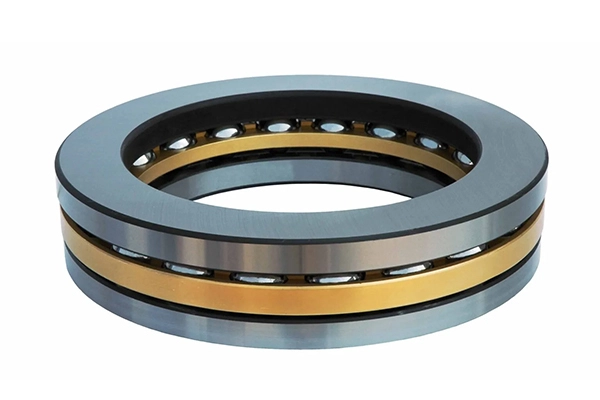How do Large Thrust Ball Bearings Handle Heavy Axial Loads?
Large thrust ball bearings are specialized components designed to handle significant axial loads while maintaining optimal performance in various industrial applications. These critical components feature distinctive structural designs that allow them to support heavy loads in one direction along the shaft axis. Unlike conventional bearings, large thrust ball bearings are specifically engineered to manage substantial axial forces through their unique arrangement of balls between two washers or races.

What makes large thrust ball bearings different from other bearing types?
Unique Structural Design for Axial Load Management
Large thrust ball bearings possess a distinctive structural configuration that separates them from other bearing varieties. Unlike radial bearings that primarily handle forces perpendicular to the shaft, large thrust ball bearings are specifically engineered to manage forces parallel to the shaft axis. The design typically includes a flat race washer, a ball and cage assembly, and a second race washer. This arrangement allows the balls to roll between the two parallel washers, creating a mechanism that effectively distributes axial loads across a larger surface area. The large thrust ball bearing's architecture incorporates specially designed raceways with optimal curvature ratios to maximize contact area between the balls and races, enhancing load capacity significantly.
Advanced Material Selection for Superior Performance
The exceptional performance of large thrust ball bearings under heavy axial loads is largely attributable to the advanced materials used in their construction. High-grade bearing steels, including AISI 52100 chromium steel or special stainless steel variants, provide the necessary hardness, dimensional stability, and fatigue resistance. For applications involving extreme conditions, large thrust ball bearings may incorporate ceramic elements, typically silicon nitride or zirconia, offering advantages such as higher stiffness, better electrical insulation, and superior performance at elevated temperatures. Surface treatments and coatings further enhance the capabilities of large thrust ball bearings, improving corrosion resistance and extending service life.

Precision Manufacturing Tolerances and Surface Finishing
The exceptional performance of large thrust ball bearings under heavy axial loads is directly linked to precision manufacturing processes. These bearings are manufactured to exacting tolerances to ensure proper load distribution and minimize stress concentrations. The surface finish of the raceways is particularly critical, with specialized grinding and polishing techniques achieving mirror-like surfaces with extremely low roughness values. This exceptional surface quality helps minimize friction and wear while promoting proper lubricant films. Rigorous quality control procedures ensure large thrust ball bearings meet or exceed industry standards and maintain superior performance under demanding axial load conditions.
How do large thrust ball bearings achieve optimal lubrication under heavy loads?
Advanced Lubrication Systems and Technologies
Large thrust ball bearings employ sophisticated lubrication strategies to maintain optimal performance under heavy axial loads. Oil bath lubrication systems are commonly used for high-speed applications, while circulating oil systems with filtration capabilities ensure contaminant-free lubricant delivery. Modern large thrust ball bearings often use specialized grease formulations featuring high-performance base oils and thickener systems designed to withstand heavy pressures. These greases typically contain extreme pressure (EP) additives and solid lubricants that create protective boundary layers on bearing surfaces. Some advanced applications utilize oil-air lubrication systems that provide precisely metered quantities of lubricant directly to critical contact areas.
Optimized Oil Film Formation and Maintenance
The efficacy of large thrust ball bearings in handling heavy axial loads depends significantly on maintaining an adequate lubricating film. This critical oil film serves as a protective barrier between rolling elements and raceways, preventing metal-to-metal contact that would otherwise lead to rapid wear. Manufacturers carefully engineer raceway profiles with slight modifications that enhance oil film formation through elastohydrodynamic lubrication mechanisms. The viscosity characteristics of the lubricant must be precisely matched to the operating conditions of the large thrust ball bearing, considering factors such as speed, load, and temperature. Modern computational models allow engineers to predict oil film behavior and optimize both bearing design and lubricant selection.
Thermal Management and Contamination Control
Effective operation of large thrust ball bearings under heavy axial loads depends on proper thermal management and contamination control. The concentrated nature of axial loading can generate substantial heat through friction, particularly at high speeds or under extreme loads. Advanced designs often incorporate cooling channels, heat-dissipating materials, or specialized coatings to manage thermal loads effectively. Equally important is contamination control, as small particles can significantly impact bearing performance by disrupting the lubricant film. Modern large thrust ball bearings frequently employ integrated sealing solutions, from contact seals for severe environments to non-contact labyrinth designs for high-speed applications. Many industrial systems also implement filtration systems that maintain lubricant cleanliness to industry standards.

What are the key applications and load capacity considerations for large thrust ball bearings?
Critical Industrial Applications and Load Requirements
Large thrust ball bearings serve as fundamental components in numerous industrial applications where significant axial forces must be effectively managed. In hydroelectric power generation, these bearings support massive turbine shafts. The maritime industry relies on them for marine propulsion systems, where they absorb tremendous axial forces generated by propellers. In oil and gas, these bearings are integral to mud pumps, drilling equipment, and vertical pumping systems. Construction and mining equipment such as tunnel boring machines and crusher assemblies depend on large thrust ball bearings to support massive axial loads. The steel manufacturing industry uses these bearings in rolling mills and continuous casting machines, while wind energy systems utilize them in main rotor assemblies and pitch control mechanisms.
Load Capacity Calculation and Selection Criteria
Selecting the appropriate large thrust ball bearing for heavy axial load applications requires understanding both static and dynamic load ratings. The static load rating reflects the bearing's ability to withstand heavy loads without permanent deformation, while dynamic load ratings indicate the load a bearing can support for a specified operational lifetime. Selection criteria extend beyond simple load ratings to include speed limitations, thermal considerations, and environmental factors such as exposure to moisture or contaminants. Installation and maintenance requirements should also influence bearing selection, as some designs offer advantages in terms of ease of mounting or condition monitoring capabilities.
Performance Enhancement Through Advanced Design Features
Modern large thrust ball bearings incorporate numerous advanced design features that enhance their capacity to handle heavy axial loads. Critical innovations include optimized ball-to-raceway contact geometry and asymmetric raceway designs that account for the predominantly unidirectional nature of axial loading. Cage designs feature pocket geometries that optimize ball guidance while minimizing friction. Material innovations have contributed to improved performance, with developments in heat treatment processes enabling bearings to achieve superior hardness and dimensional stability. Hybrid large thrust ball bearings incorporating ceramic balls offer advantages including reduced centrifugal forces and lower friction. Some advanced bearings now include integrated sensors for real-time tracking of critical performance parameters, enabling predictive maintenance strategies.
Conclusion
Large thrust ball bearings represent specialized engineering solutions specifically designed to handle heavy axial loads in diverse industrial applications. Their unique structural configuration, advanced materials, precision manufacturing, and optimized lubrication systems collectively enable these critical components to provide reliable performance under the most demanding conditions. By carefully considering application requirements and leveraging modern design innovations, engineers can select appropriate large thrust ball bearings that deliver optimal performance and longevity.

Luoyang Huigong Bearing Technology Co., Ltd. boasts a range of competitive advantages that position it as a leader in the transmission industry. Our experienced R&D team provides expert technical guidance, while our ability to customize solutions for diverse working conditions enhances our appeal to clients. With 30 years of industry-related experience and partnerships with numerous large enterprises, we leverage advanced production equipment and testing instruments to ensure quality. Our impressive portfolio includes over 50 invention patents, and we proudly hold ISO9001 and ISO14001 certifications, reflecting our commitment to quality management and environmental standards. Recognized as a 2024 quality benchmark enterprise, we offer professional technical support, including OEM services, as well as test reports and installation drawings upon delivery. Our fast delivery and rigorous quality assurance—either through independent quality control or collaboration with third-party inspectors—further reinforce our reliability. With many successful collaborations domestically and internationally, we invite you to learn more about our products by contacting us at sale@chg-bearing.com or calling our hotline at +86-0379-65793878.
References
1. Johnson, K.L. (2022). Contact Mechanics of Ball Bearings Under Heavy Axial Loading. Journal of Tribology, 144(3), 031701.
2. Zhang, H., & Wang, Y. (2023). Advanced Materials and Manufacturing Processes for High-Performance Thrust Ball Bearings. International Journal of Precision Engineering and Manufacturing, 24(2), 289-305.
3. Smith, R.B., & Patel, K. (2021). Lubrication Strategies for Thrust Ball Bearings in Heavy Industrial Applications. Tribology Transactions, 64(5), 878-891.
4. Nakamura, T., & Rodriguez, S. (2023). Thermal Management in Large Thrust Ball Bearings Under Extreme Operating Conditions. Journal of Engineering for Gas Turbines and Power, 145(6), 061008.
5. Lindberg, A., & Vasquez, M. (2022). Comparative Analysis of Hybrid and Conventional Thrust Ball Bearings for Wind Turbine Applications. Wind Energy, 25(7), 1233-1249.
6. Chen, W., & Thompson, J. (2023). Computational Modeling of Elastohydrodynamic Lubrication in Thrust Ball Bearings. Proceedings of the Institution of Mechanical Engineers, Part J: Journal of Engineering Tribology, 237(4), 674-689.

